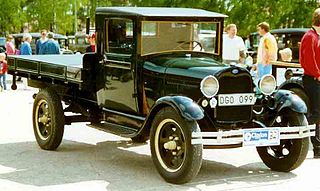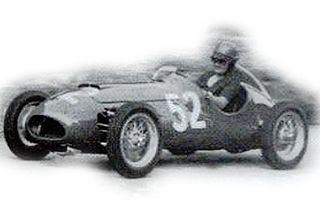The Amilcar was a French automobile manufactured from 1921 to 1940.

Trojan was a British automobile manufacturer producing light cars between 1914 and 1965, and light commercial vehicles for a short time.

The Citroën Type A was produced from June 1919 to December 1921 in Paris, France. It was the first car Citroën made. 24,093 were built.

The Alfa Romeo 90 is an executive car produced by Italian car manufacturer Alfa Romeo between 1984 and 1987.

Ford Model AA is a truck from Ford. As the Model T and TT became obsolete and needed to be replaced, Henry Ford began initial designs on the Model A and Model AA in 1926. Basic chassis layout was done rapidly and mechanical development was moved forward quickly. Body design and style was developed and then outsourced to various body manufacturers, including Briggs and Murray. The designs of the Model A shared parts and materials with the Model AA Ford, notably the body, engine and interior. The AA usually received plainer interiors than their car counterparts. The Model AA followed similar design changes to the Model A during the AA's four years in production, often delayed anywhere from three to nine months. The mechanical changes and upgrades were done during production of the vehicles. Body changes that occurred between 1929 and 1930 were also integrated into AA production, but leftover parts were used longer in the heavy commercial trucks.
Morris Cowley was a name given to various cars produced by Morris from 1915 to 1958.

The Fiat 518, also called Fiat Ardita, was a model of car produced by Italian car manufacturer Fiat between 1933 and 1938. The name "Ardita" was also used on the six-cylinder engined and more expensive Fiat Ardita 2500 or 527.

The Citroën Type C was a light car made by the French Citroën car company between 1922 and 1926 with almost 81,000 units being made. Known as Citroën 5HP or 5CV in France and 7.5HP in Britain, it was the second model of automobile designed and marketed by André Citroën, between 1922 and 1926. It followed the 10HP "Type A " (1919), then 10HP "B2" (1921); they were the first European mass-produced cars.
Motorcycle components and systems for a motorcycle are engineered, manufactured, and assembled in order to produce motorcycle models with the desired performance, aesthetics, and cost. The key components of modern motorcycles are presented below.

The Austin 10 hp is a high-quality small car produced between 1910 and 1915 by the British car manufacturer Austin Motor Company Limited at their Longbridge, Worcestershire plant near Birmingham. 1,336 cars were made, 213 with the 1125 cc engine and 1,123 with the 1615 cc engine. Like the 1087 cc Austin 7 hp produced by both Austin and Du Cros's Swift Motor Company it was not very successful when sold with the small engine.

The original Citroën Rosalie was a light-weight racing car that established a succession of records at the Montlhéry racing circuit. More generally the Rosalie was a range of three models/sizes of automobile that comprised the core of Citroën's model range between 1932 and 1938. The three models were originally designated respectively the 8CV, the 10CV and the 15CV, the numbers defining the cars' fiscal horsepower which in turn defined the approximate engine size of each model. After the introduction of the new Traction Avant, the lineup was modified and at the 1934 Paris Salon the two smaller models became the 7UA and the 11UA, now with the overhead-valve engines from the Traction. Starting with the 1933 model year Citroen offered the 1,766 cc 11UD diesel engine option.

The Rolls-Royce 30 hp was one of four cars to be produced as a result of an agreement of 23 December 1904 between Charles Rolls and Henry Royce. Badged as a Rolls-Royce, the 30 hp was produced during 1905 and 1906 by Royce's company, Royce Ltd. at its factory in Cooke Street, Hulme, Manchester. It was sold exclusively by Rolls' motor dealership, C.S.Rolls & Co., at a price of GBP 890. The engine was exhibited at the Paris Salon in December 1904, along with the 10 hp, 15 hp and 20 hp models.
The Rolls-Royce 20 hp was one of four car models to be produced as a result of an agreement of 23 December 1904 between Charles Rolls and Henry Royce. Badged as a Rolls-Royce, the 20 hp was produced during 1905 and 1906 by Royce's company, Royce Ltd. at its factory in Cooke Street, Hulme, Manchester. It was sold exclusively by Rolls' motor dealership, C.S.Rolls & Co., at a price of GBP650. The 20 hp was exhibited at the Paris Salon in December 1904, along with the 10 hp, 15 hp and engine for the 30 hp models.

The Lancia Trikappa is an automobile produced by Lancia between 1922 and 1925. It was a luxury car, offered as the flagship of Lancia's production. The Trikappa 4.5-litre V8 is notable as the first of Lancia's narrow V engines, a distinguishing feature the manufacturer only abandoned in the 1970s. The car was offered as a bare rolling chassis, as torpedo or 6-seater coupé de ville. In total 847 were manufactured.

The Bedford CA was a distinctive pug-nosed light commercial vehicle produced between 1952 and 1969 by Bedford in Luton, England.

The Bandini formula three is a racing car model produced from 1954 until 1958 by Bandini Automobili of Forlì.

The Vauxhall 30–98 is a car manufactured by Vauxhall at Luton, Bedfordshire from 1913 to 1927. In its day, its best-known configuration was the Vauxhall Velox standard 4-seater with open tourer body. Vauxhall's own description was the 30–98 hp Vauxhall-Velox sporting car. The 30–98 is also known to enthusiasts by Vauxhall's chassis code E.

Wilson-Pilcher was an English car company founded in 1901 and acquired by Sir WG Taken Armstrong Whitworth & Co., Limited in 1904.

Their new Daimler 22 horsepower full-size luxury car was first displayed by Daimler in April 1902 at The Automobile Club’s Exhibition in London's Agricultural Hall. Daimler had elected to drop their multiple old low powered designs and restrict themselves to this 22 horsepower and a pair of 9 or 12 horsepower cars to the same design as the 22 but more lightly constructed. The King’s not quite finished new Daimler 22 was reported to be the chief attraction of the show.

The Alvis 10/30 is a car introduced by British car maker Alvis Car and Engineering Company Ltd in 1920. It was the company's first production vehicle and was made until 1923. A range of body styles was available.
















